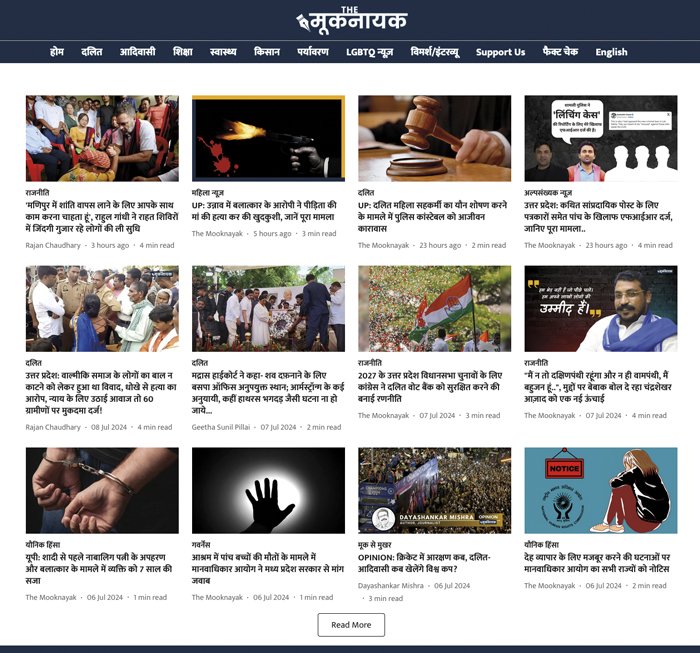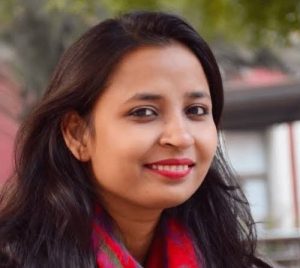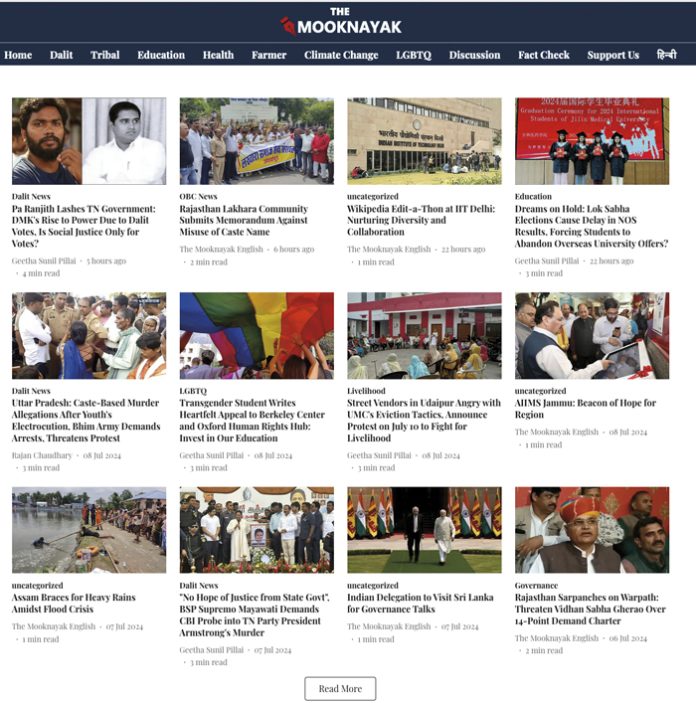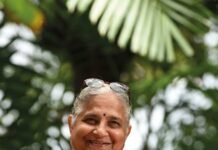Mooknayak, launched on 31 January 1920, was a newspaper started by Dr Bhimrao Ambedkar, who is known as the father of the Indian constitution. The word ‘Mooknayak‘ translates to the leader of the voiceless and laid the foundation of dalit politics in India.
Inspired by the work done by Dr Ambedkar’s Mooknayak in changing the socio-political debate on untouchability and casteism in India, journalist Meena Kotwal launched the news organization The Mooknayak on 31 January 2021, the same date when the original Mooknayak was launched by Dr Ambedkar, one hundred and one years ago.
Kotwal started The Mooknayak as a means to construct something positive out of her anger against the Indian mainstream media where journalists from the dalit community are not given the space and opportunities to pursue journalism from their point of view.
During her journalistic stint in mainstream media, Kotwal says she experienced a lot of casteism in the newsrooms. This led her to write stories on how casteism and patriarchy are practiced in Indian newsrooms and how the stories involving dalits, tribals and marginalized communities are not written from their perspective despite their representation in the mainstream media.
Kotwal faced criticism over her stories on how casteism and patriarchy are practiced in Indian newsrooms and for writing pieces on marginalized communities from their perspective. After these stories, Kotwal says she was termed as a ‘troublemaker’ and denied any opportunities in the mainstream media.
Journalists from the dalit background are not very vocal about the issues they experienced, she said in a Zoom interaction with Indian Printer & Publisher. The mainstream media houses, she says, look for journalists who adhere to their work culture and adopt their rules and regulations, and are not vocal about issues faced by dalits or marginalized communities.
After facing several rejections from the mainstream media, Kotwal looked for opportunities in the alternative media and worked for several news organizations for free before starting The Mooknayak on YouTube in the middle of the Covid-19 pandemic. On her channel, she covers issues and problems related to the marginalized communities in India. “I experienced patriarchy even while working with Bahujan YouTubers in alternative media platforms. My stories used to go viral on social media as nobody else was doing these kinds of stories,” she said.

Kotwal, a postgraduate in mass communication, has a keen understanding of journalism and how to take a media website forward. While deciding on a name for her news organization, Kotwal zeroed in on several titles but decided to carry forward Dr Ambedkar’s legacy. Dr Ambedkar had always kept his newspaper copyright-free and this allowed Kotwal to use the name.
Many others had launched YouTube channels and websites named Mooknayak before us, and that was another reason why she decided on The Mooknayak. “We share the same motive as Dr BR Ambedkar – to work for the marginalized communities of India,” she said.
“India has a huge population and so it’s not possible to completely ignore dalit issues. However, the stories are not told from their perspective. The problem lies more with ‘what’ is being done and ‘how’ it is being done,” she said.
Today, The Mooknayak is run by a trust called the Critic Media Foundation. The team consists of 12 permanent employees – dalits, tribals, OBCs, Muslims and even from upper castes. According to Kotwal, when you have people from all social backgrounds in the newsroom, it enhances the way the stories are presented.
Oxfam India and Newslaundry did a study between April 2021 and March 2022 titled Who Tells Our Stories Matters: Representation of Marginalised Caste Groups in Indian Media. According to the study, 88% of the top leadership positions in Indian media, including print, TV and digital platforms such as YouTube and news websites, were held by people from the general category. In print media, less than 5% of the articles were written by journalists from the scheduled caste/scheduled tribe communities while 10% belonged to other backward classes, Kotwal quoted.
“Dalit and tribal issues can best be told by dalits and tribals, who have personally lived through those experiences and have a thorough understanding of their issues,” Kotwal said.
“If you pick up any newspaper, you will notice that stories on dalit and tribal issues are placed in small columns in a corner or downplayed, she said, alleging that these communities are portrayed as weak while the dominant castes are portrayed as strong.
She took the example of the 2020 Hathras gang rape and murder, which she said did not feature much in the mainstream media as the victim was a dalit woman. On the other hand, alternative media such as YouTube channels and news websites worked relentlessly to bring the issue to light. Eventually, the mainstream media was forced to highlight the case but added a Naxalite angle. Another case inadequately covered by the mainstream media was the Delhi Cantt rape, where a nine-year-old dalit girl was allegedly raped by a priest, killed and forcibly cremated in Nangal village, she said.

Kotwal talked about the rape of an 11-year-old tribal girl in Rajasthan’s Hindaun. The case had not been covered by any mainstream and alternative media before she reported it, she said, adding the deaf and mute girl was not able to communicate properly due to pain in her hands. Her private parts were burned so that no tests could be conducted for rape, Kotwal said. “I talked to everyone there, even the culprit’s family as I thought their angle is important in the story. I talked to the police authorities, who were not cooperative.” She said people from the accused’s caste handled the case and wanted to protect them.
Kotwal said even if dalits are in the wrong in some cases, she doesn’t don’t shy away from sharing those stories on The Moooknayak.
Many students from marginalized backgrounds graduate from journalism schools but never make it to the newsrooms. And even if they do, they are mostly sidelined, she said. They either start their own YouTube channels or go back home and prepare for entrance exams for government jobs or get busy with household work, she shared. “If journalists from the dalit and tribal backgrounds are not represented in mainstream media, how will their stories be covered?” she asked.
History is being modified in NCERT textbooks and information on dalits and their society is being removed, Kotwal said, adding she had done a story on the topic after a study by IIT Bombay. “When young dalit children read these textbooks and find no representation of their community, they are bound to feel inferior. How will we, as parents, make them understand that we come from a community that is marginalized and sees lesser representation than the so-called upper castes.”
She said it is the same with the media, where stories and issues about dalit and other castes are not covered and even if they are, they are shown in a manner that their upper caste privilege is not spoilt. Caste is a huge issue in India but the media doesn’t address these issues in the way they need to be addressed, she added.
Challenges in journalism
“Whenever a journalist from a dalit background enters a newsroom, he or she is termed as a ‘dalit journalist.’ But journalists from other castes are never referred to as a ‘Bania journalist’ or a ‘Rajput journalist’ or a ‘Brahmin journalist’ – they are simply journalists,” Kotwal argues, adding the concept of using caste in a profession is wrong.
One of the biggest challenges in journalism is that wherever you reach, your caste reaches before you, Kotwal shared, adding this was the primary reason she was termed as a ‘troublemaker’ and was not able to secure a good position in a mainstream newsroom or even alternative media channels.
“When you are defined as a ‘dalit journalist,’ people assume that you must be biased and into activism. I worked with an international news organization for about two years and wrote stories that won awards. Despite that, I was not able to secure a job in the mainstream media. Just because I am writing about dalit issues and rights, I don’t become a ‘troublemaker’,” she said.
“When journalists from the upper class work on stories about dalits, they are said to be liberal and progressive, and when we try to bring our stories to the fore, we are termed as troublemakers,” she said, adding if she is a trained journalist and can read and write proficiently, why can’t she write about dailts and marginalized communities?.
Funding concerns
She said her media house received a lot of praise for their work but there is always a lack of funding and support from the media fraternity. “Running the team of The Mooknayak gets very challenging at times, as we don’t have funds to pay salaries. In the initial days, I started working alone but over time work increased and along with it the team. We received appreciation from Oxfam International for our inclusive team and international media outlets. We resorted to crowdfunding for some time, but it doesn’t work for long,” she said.
Kotwal said when she started receiving appreciation from the international media, people from her own community questioned how can a dalit woman run a media organization of this scale. She says she became a victim of online trolling due to which crowdfunding stopped. One independent media organization supports them with 50% funding, she said.
“Even getting 50% support is a challenge given the current scenario. We have to delay our salaries due to funding issues. There is a passion for unbiased storytelling in our team, which is what holds us together,” she added.
Rise of alternative media
YouTube has given alternative media journalists the power to set up a channel without money, Kotwal said, adding when she started, she just wanted to work on issues related to marginalized communities. YouTube gave her the hope and the power to start The Mooknayak on her own, despite a stable job and lack of funds. “After some time, I started working on our English website, which has given us both national and international recognition and is working better than the YouTube channel,” she added.
“We do a lot of ground reports, which do not appeal to the audiences’ tastes. People are more interested in debate and discussion-based TV shows. Fewer people watch ground reports, but we have a serious audience there. YouTube and Twitter have given me the power to share my opinions with the world with a smartphone,” she said.
Alternative media has saved the foundation of media in India today as the mainstream media has brought down India’s rank to 159 in the World Press Freedom Index, she said. “Dalits and tribals working independently are not a part of these rankings and can’t be blamed because they haven’t reached the position of mainstream media.”
“I have completed my graduation and postgraduation in mass media and in touch with media professionals from many leading news organizations. People recognize me for the work I have done for the marginalized communities in India,” Kotwal says on recognition and media acceptance.
The Mooknayak has a good reach in the Hindi belt of Uttar Pradesh, Madhya Pradesh, Rajasthan, Delhi-NCR, and Bihar. However, Kotwal is not content and would like to expand operations to the North in Jammu & Kashmir, the Northeast as well as Southern states. The main purpose of our English website is to connect with audiences across the country, she said, that they are gradually thinking of expanding our operations in Maharashtra in Marathi.
Whether you like The Mooknayak or not, we have reached a position where you won’t be able to ignore it anymore, she concluded.
This article in from the August issue of Indian Printer & Publisher which will go to press on 20 July 2024.


















